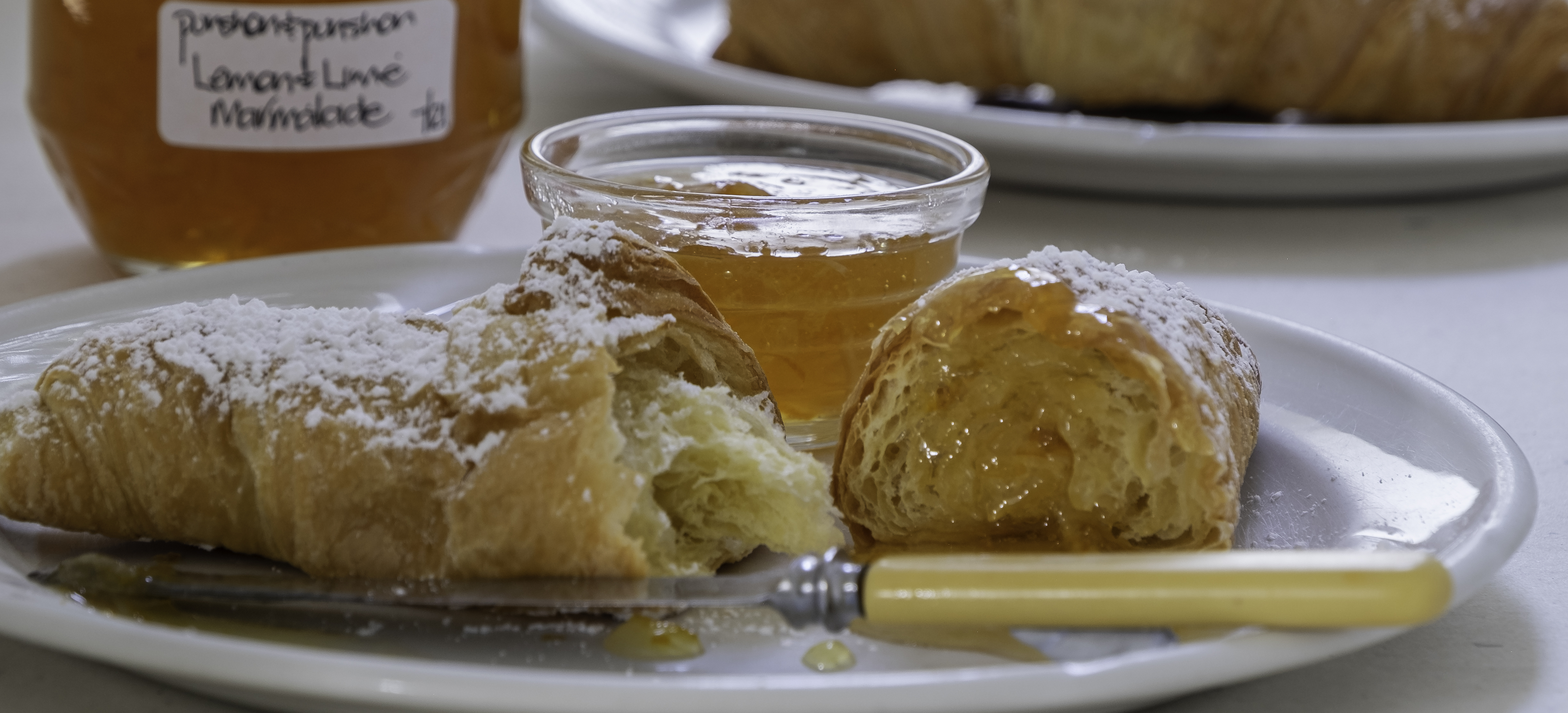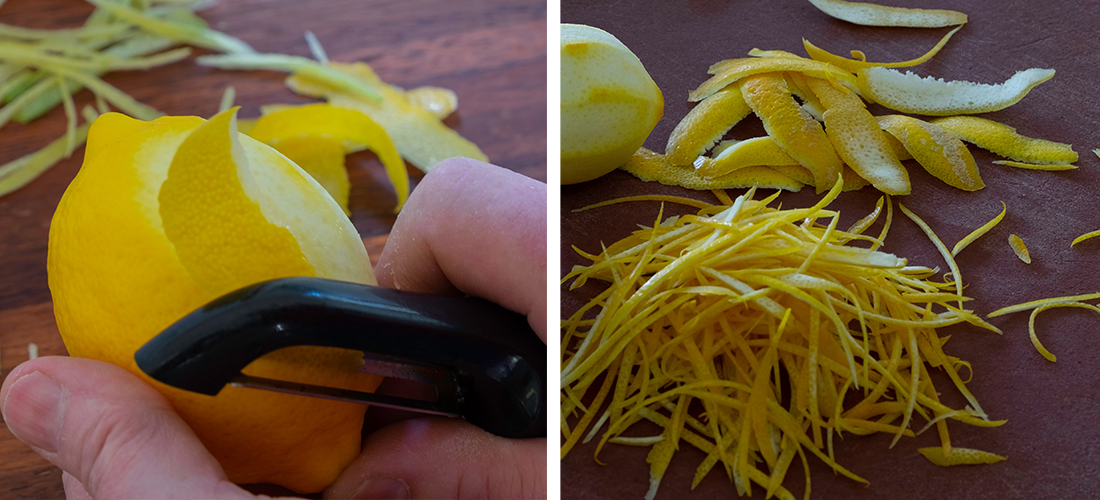Lemon & Lime Marmalade
- Jams, Jellies & Marmalades

Lemon and lime combine to make a tangy, aromatic and cleansing marmalade. Different to the more traditional orange and chunky peel style, the flavour and texture is more refined. The combined aromatics from the lemon and lime peel, add pine, eucalyptus, and lavender undertones to this citrusy masterpiece. Its flavour, however, is not without a tantalising attitude that you’ll either love or decide it’s not for you. Served on hot buttered sourdough toast or a buttery croissant with a cup of Irish Breakfast tea, is my perfect way to start the day.
While lemons and limes are abundant, extend your repertoire and make a small batch. There is always a lemon and lime marmalade lover moseying around during the marmalade season.
- Preparation Time:
- 30-40 minutes
- Cooking Time:
- 90 minutes
- Quantity:
- 6 x 400 ml
INGREDIENTS
- 500g
- Lemons
- 500g
- Limes
- 2 kg
- White sugar
- 2 litres
- Water

METHOD
Wash the fruit skin to remove any garden debris or wax, if they have been commercially grown. Using a vegetable peeler, remove the peel from the lemons and limes.
Place a piece of peel, skin side down on a chopping board and cut peel into thin strips and put aside. This will become the peel shreds in the marmalade.
Remove any excess pith from the fruit and cut up the fruit. Keep the juice, pips, and pith aside to make the pectin bag in the next step.
Make a pectin bag with the pips, membrane shell and a small handful of pith. Refer to the Notes section below on how to make a pectin bag.
Place the shredded peel, chopped fruit, water, and pectin bag in a large heavy bottom preserving pan or saucepan.
Bring the mixture to boil over high heat then reduce to a light simmer with the lid on until the peel is soft: approximately 50 minutes. Refer to the peel test in the Notes section below.
Using gloves remove the pectin bag and squeeze to extract as much juice and pectin as possible. Put aside.
Add a third of the warmed sugar and stir to quickly dissolve. Repeat the process 2 more times until all the sugar is dissolved. Bring to the boil and allow to boil rapidly until it's set. Test to see if it has reached the setting point. If not, continue to boil and keep checking every 2 minutes until it reaches the set point using either the flake or wrinkle test. Alternatively boil until it reaches 105 C/220 F.
Remove from the heat and place on heat resistant surface.
-
With a stainless spoon or any spoon that has relatively fine edge, skim the top of the marmalade to remove any scum that has accumulated during the cooking.
Allow to cool slightly for approximately 5-10 minutes, then stir gently to distribute the peel evenly. Using a funnel pour into dry warm sterilised sealable bottles and fill to approximately 2.5cm (1 inch) from the top of the bottle. Seal while the marmalade is hot.
-
Label and store in a cool dark place in the kitchen or pantry.
Allow the marmalade to mature for at least 2 weeks before enjoying.
NOTES
- Use fresh citrus that have been recently picked as the pectin content is likely to be higher. Pectin is concentrated in the seeds, pith and cores of the fruit. Don’t discard them, as they are invaluable in jam and marmalade making as it is the ratio between the fruit acids, pectin and sugar that makes them set.
- To wash the fruit, I use a pair of Skrub’a vegetable gloves. A wonderful invention made of a slightly course material that magically scrubs fruit and vegetables with the greatest of ease. Easy to wash and dry–they are an indispensable item in my kitchen. Special thanks to my very dear friend Sue who found them in a cookware shop. Alternatively use a kitchen vegetable brush.
- Depending on the lemon and lime variety, the thickness of the pith will vary. Small, thin-skinned lemons tend to be juicers and perfect for making curd. The larger varieties have a higher proportion of peel and pith to flesh and are better suited to making marmalade. However, don’t be put off from using the thin-skinned lemons for marmalade.
- The pith of bitter oranges becomes translucent during cooking, the pith of other citrus fruits remains opaque. This doesn’t affect the flavour and texture, however, if you want a clear appearance, remove the pith and place some of it in the pectin bag.
- To make a pectin bag, drape clean sterilised calico or muslin cloth, approximately 200cm square, over a bowl. Place the pith, seeds and membrane shell in the cloth. Gather up the ends and close the bag by tying it up tightly with smooth kitchen string. Allow plenty of room between the contents and tie point so the citrus water can bubble through the bag and extract the pectin from the pith, seeds and membrane shell. Do not put too much pith in the pectin bag otherwise the marmalade can take on a bitter taste. It’ s now ready to use. Discard the fruit in the bag once it has been removed from the preserving pan. The cloth can be washed, dried and kept for the next batch. My tea towel draw has a range of different size cloths that are on hand for my jam and marmalade experiments.
- To warm the sugar, put the recipe quantity in oven proof container and place in a preheated 120 degrees C oven for approximately 10 minutes. The sugar should be warm to touch, not hot. Warmed sugar, dissolves quickly and a rapid boil, until the setting point is reached, helps to preserve the fresh citrus flavour.
- If you don’t have a preserving pan, use large heavy bottom pot, preferably stainless steel. Ensure there is enough space available in the pot for the mixture to double in size while it is rapidly boiling.
- To test if the peel is cooked, squeeze a piece of peel between the thumb and finger. It should easily squeeze to a mush.
- Lime skins tend to be tougher than other citrus fruit, so it’s important to finely shred the peel and to cook it until it's soft before the sugar is added
Happy marmalading
